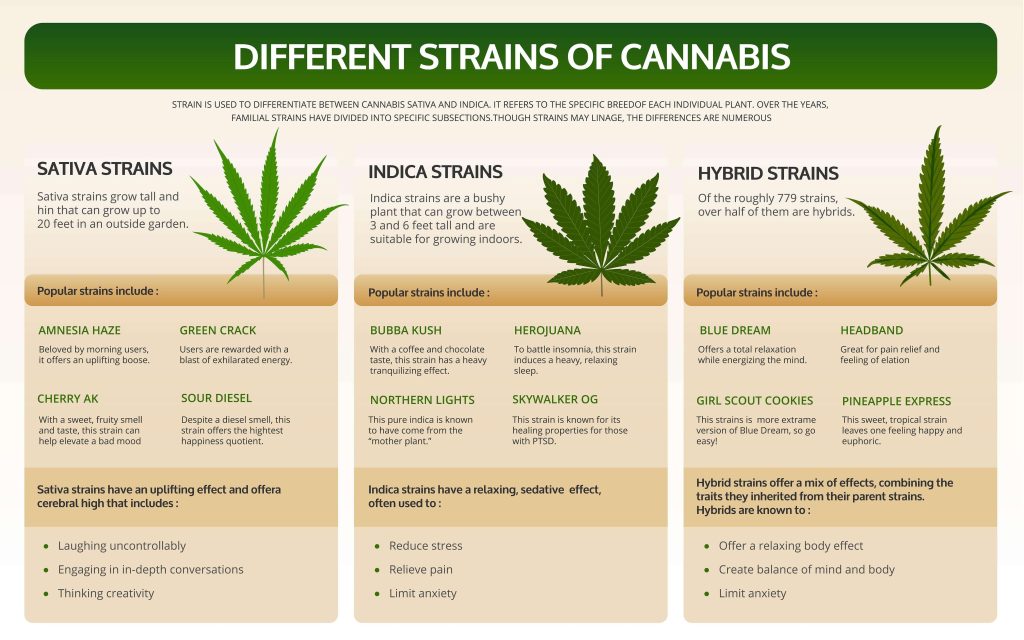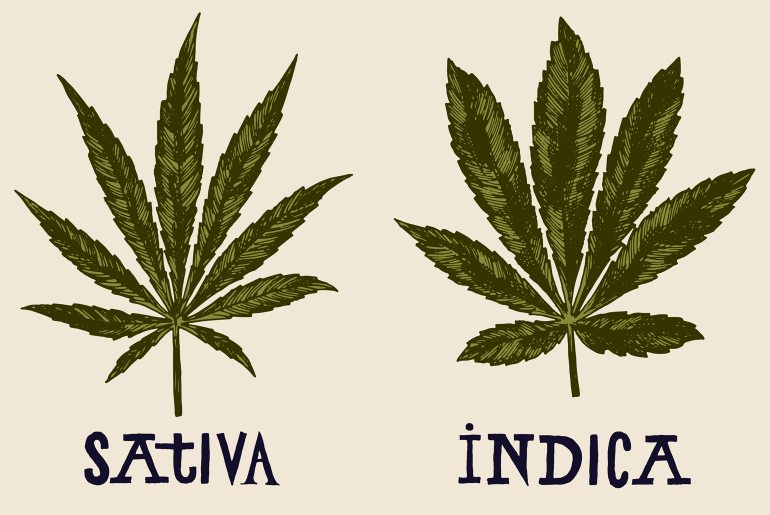The cannabis industry is a diverse one that has grown over many years to encompass a wide array of strains, each with its own unique properties and effects. Among the countless varieties available, Sativa and Indica stand out as the two primary classifications that shape the cannabis experience. Both types have origins that date back to the 18th century, and from that time until now, many strains have developed, with several known as hybrids that include a combination of both Indica and Sativa genetics. Comparing Sativa to Indica is like comparing black to white. They both have very distinctive differences, from the lengths of their leaves to their shapes, effects, and much more. As you read on, you will discover the origins and characteristics of Sativa and Indica that make them so different from each other.
Sativa Marijuana
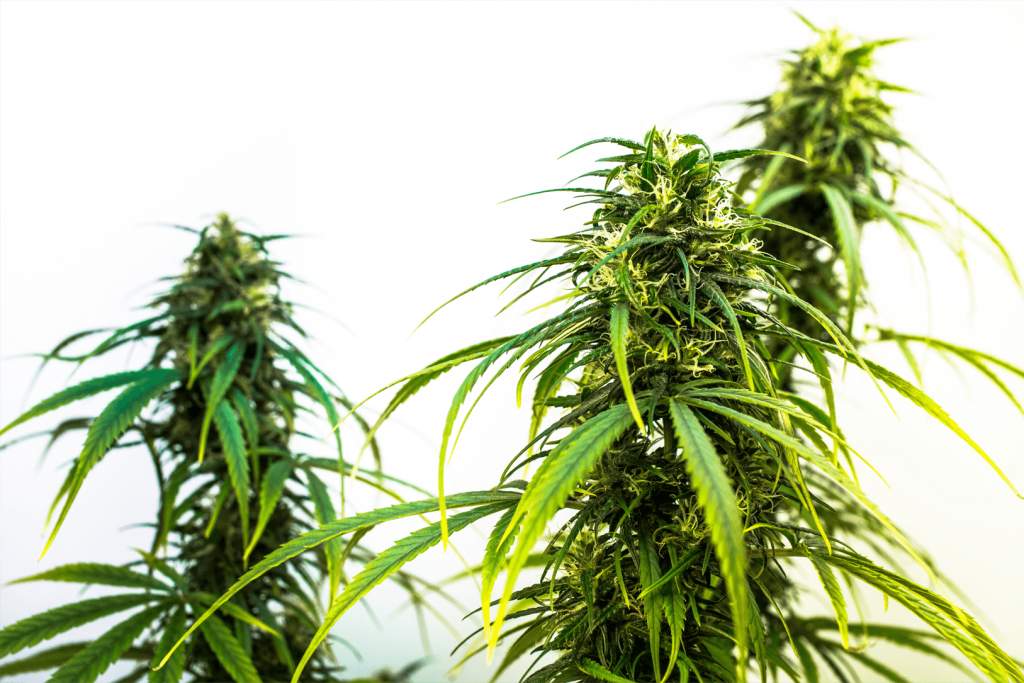
Sativa is a species of cannabis that was first classified by Carl Linnaeus in 1753 and has origins in warmer parts of the world such as Southeast Asia, South Africa, and Central and South America. Sativa strains are characterized by taller, thinner plants with narrower leaves. They are often referred to as “uppers” because they provide a more cerebral and uplifting high with potential effects such as creativity, focus, and a sense of well-being. The term “upper” is quite fitting for Indica, as it has the ability to sharpen the senses of users and make them feel more alive. In fact, it has both anxiolytic and antidepressant effects, which will be discussed further in the article.
Indica Marijuana
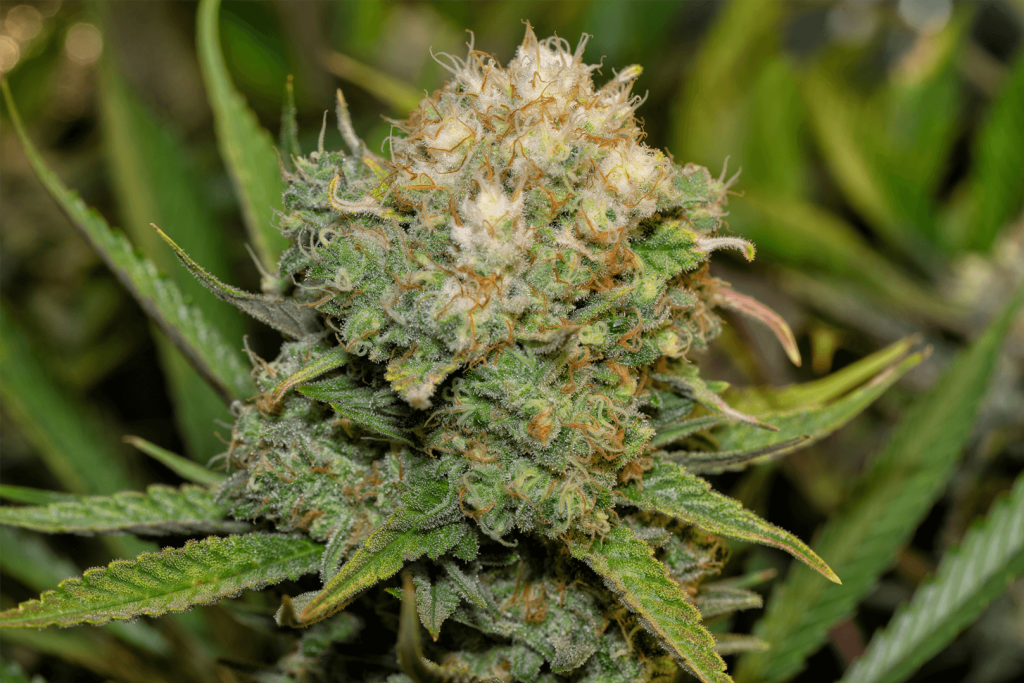
The Cannabis Indica plant originated in the Middle Eastern parts of the world, specifically in Afghanistan, Tibet, and Pakistan. This species of Cannabis was classified by Jean-Baptiste Lamarck in 1785 and is characterized by shorter, bushier plants with broader leaves. Indica strains are commonly referred to as “downers” due to their calming effects, such as relaxation, pain relief, and sleepiness. The effects of Indica are primarily physical, with users experiencing a body-centric high after consumption. These strains contain higher levels of myrcene and CBD, which contribute to their relaxing and sleep-inducing properties.
Physical Properties
Recently, there has been a rise in the number of hybrids combining Sativa and Indica, making it less straightforward to identify each strain based only on their appearance. In the following sections, you will discover the distinctions between these two strains, including their visual characteristics, aroma, growth patterns, and more.
Leaf Shape and Size
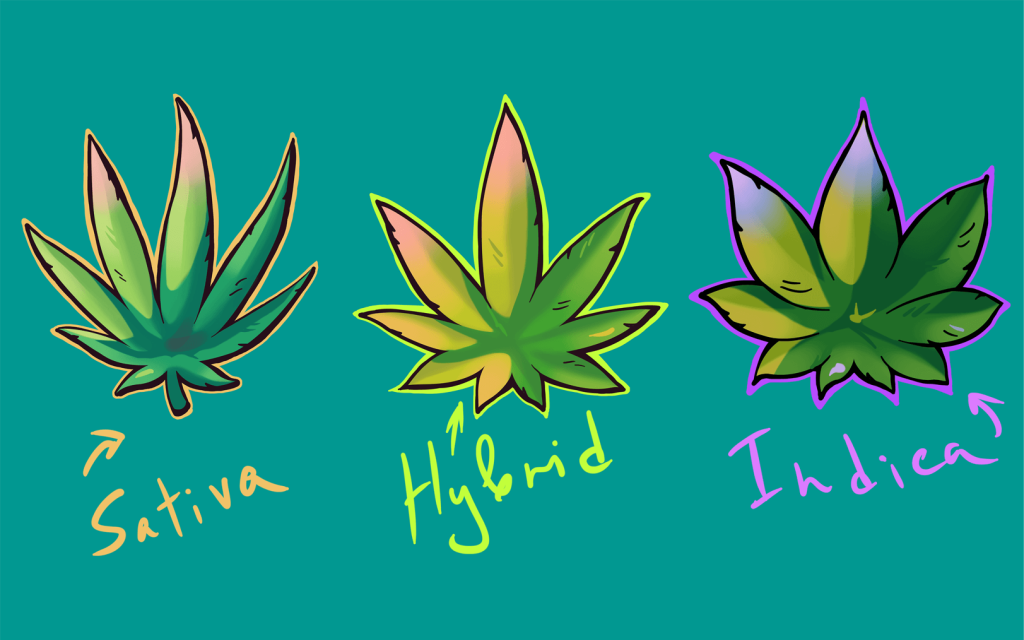
Sativa leaves may appear more recognizable to you, as they are commonly depicted on stickers, T-shirts, and other graphic designs. These leaves have a taller and narrower structure. On the other hand, Indica strains typically feature broader and wider leaves with shorter leaflets. Indica plants tend to grow shorter and bushier, while Sativa plants are usually tall and slender, reaching heights of up to 12 feet when grown outdoors. One simple way to distinguish between these two types of leaves is by their width. Indica leaves are often double or even triple the width of Sativa leaves.
Bud Structure
When it comes to buds, Indica strains have the advantage. Indica buds tend to be thicker and produce a greater quantity of flowers compared to Sativa buds. Indica buds are typically denser and compact, displaying a chunky appearance. On the other hand, Sativa buds are lighter, longer, and airier, taking on a cylindrical shape. If you come across a wide and tightly packed bud, it is likely an Indica bud, whereas the opposite characteristics would Indicate a Sativa bud.
Growing Conditions and Flowering Time
Sativa plants thrive in warmer zones and tropical climates, while Indica plants are best suited for cooler climates at higher altitudes. The flowering period of Sativa strains typically ranges from 10 to 14 weeks, whereas Indica strains generally have a shorter flowering time of 7 to 9 weeks. Due to their hardiness and higher yield potential, many growers prefer Indica plants over Sativa plants.
Smell
Most people find it difficult to recognize cannabis strains based solely on their smell, but it’s quite easy with Sativa and Indica, as they have very different smells. Sativa strains have a sweet smell that is often fruity or spicy, while Indicas have an earthy, heavier, and mustier odor. Sativas smell more pleasant in comparison to Indicas, which have a skunk-like aroma. The reason for the difference in how both strains smell is Terpenes
Chemical Properties
Sativa and Indica are also different in terms of their chemical compositions and the smoking effects they have on the body and mind.
Cannabinoid Compositions
The chemical compounds found in cannabis, known as cannabinoids, have varying concentration levels in Sativas and Indicas. Sativa strains are associated with higher levels of the cannabinoid cannabidiol (CBD), while Indica strains often have higher levels of tetrahydrocannabinol (THC). However, there are hybrid and strain varieties that contain different combinations of THC and CBD, depending on the dominant type. Many Indica strains contain both cannabinoids.
Terpene Profiles
Terpenes are aromatic compounds found in cannabis that are responsible for its distinctive flavors and smells. Sativa strains have terpene profiles containing higher levels of terpinolene or limonene, while Indica strains have terpene profiles that can include higher levels of myrcene. These compounds produce different effects on the brain and body when ingested.
Mental and Emotional Effects
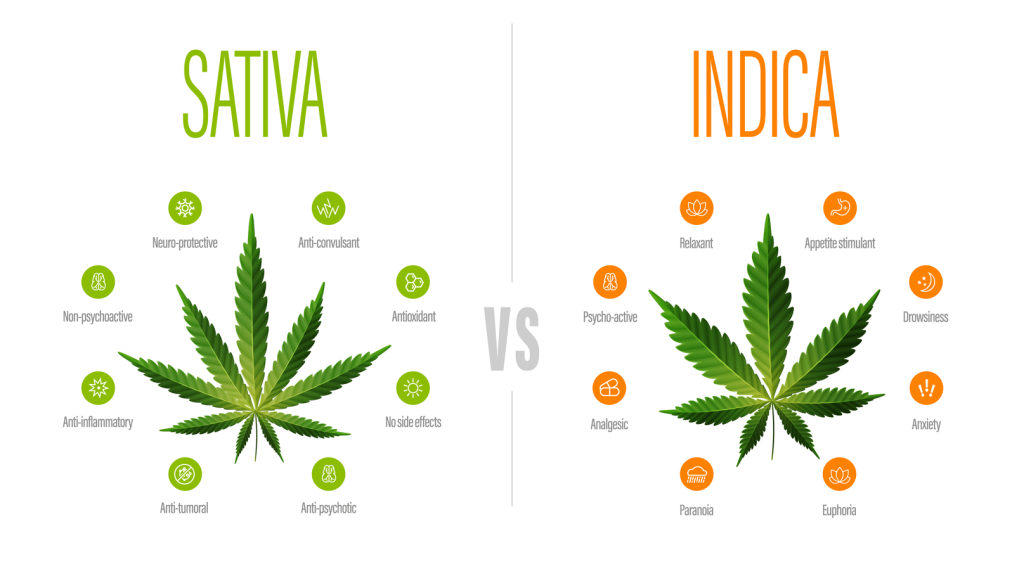
Indica and Sativa strains have different effects on our brains and emotions. Sativa is commonly regarded as daytime cannabis due to its natural ability to increase energy and focus. It can also help individuals with attention difficulties, such as ADHD, feel calmer and more composed. On the other hand, Indica typically induces a relaxing effect on the mind, promoting sleep. This is why many people prefer to consume Indica strains at night.
Physical Effects
Indica strains have characteristics similar to depressants and are known to help relax muscles. Indicas primarily affect the body, while Sativas tend to have a stronger impact on the mind. Indica strains provide a ‘body high’ by promoting muscle relaxation and reducing tension in the body. On the other hand, Sativa strains are natural stimulants that can elevate mood and provide increased energy.
Medicinal Effects
Indica strains are known for their relaxing and calming effects, making them useful in reducing stress, anxiety, and promoting a sense of tranquility. These strains also possess analgesic properties that help alleviate chronic pain, headaches, and migraines. Indica strains are particularly effective in inducing sleep, making them beneficial for individuals with sleeping disorders or insomnia. Furthermore, they act as appetite stimulants, which can be helpful for those experiencing a loss of appetite due to medical conditions or treatments like chemotherapy. On the other hand, Sativa strains provide a mood boost, enhance creativity, and stimulate the mind. They can improve focus, mental clarity, creativity, and productivity. These strains produce a euphoric effect and can be useful for people dealing with depression. Sativas are less likely to induce drowsiness and can aid in combating fatigue.
Strains
Within the broader categories of Indica and sativa, there are numerous specific strains of cannabis. These strains are often named and bred based on their unique characteristics, such as their cannabinoid and terpene profiles, growth patterns, and effects. Sativa strains are mostly powerful and energetic or fruit-themed, whereas Indica strains often have names that convey a sense of calmness and mellowness.
Popular Sativa-Dominant Strains
- Lemon Haze: This strain is made by crossing Lemon Skunk with Silver Haze. It smells and tastes like freshly peeled lemon slices, and is great for regulating mood disorders.
- Durban Poison: Originating from South Africa, this pure sativa is a highly energetic strain popular for its sweet smell that can provide a clear-headed and focused high.
- Sour Diesel: This strain is famous for its potent diesel-like aroma and energizing effects, often described as a “heady” high. It is also called “Sour D” or “Sour Deez”.
- Super Silver Haze: This is a popular strain among cannabis enthusiasts with a ratio of 70:30 between Sativa and Indica. It generally promotes creativity, productivity, and sociability.
- Green Crack: Despite its controversial name, Green Crack is known for its energetic and uplifting effects and is an excellent choice for those who need to stay focused throughout the day.
Popular Indica-Dominant Strains
- OG Kush: This popular strain was first cultivated in the early 90s, and it offers relaxation, euphoria, and potential pain relief.
- Pennywise: A strong, high-CBD strain created by crossing Harlequin and Jack the Ripper strains. It is useful in treating arthritis and PTSD.
- Northern Lights: Known for its potent relaxing effects and ability to relieve pain and insomnia. It is one of the most popular Indica strains of all time.
- Blueberry: Noted for its sweet and fruity flavor, as well as its relaxing and stress-relieving effects. It is made by crossing Purple Thai with Thai.
- Purple Kush: This is a pure Indica strain that has been proven to be helpful for headaches, migraines, and pain in general. It is famed for being the best nighttime cannabis option.
Conclusion
Sativa and Indica include a wide range of strains that generally exhibit their respective main properties of being stimulants and depressants. However, through hybridizations and crossings between these two major classifications, some strains can display a combination of both features or possess unique physical and chemical properties.
As the cannabis industry continues to evolve, there is a growing trend towards categorizing strains based on their chemical profiles in addition to their physical properties. This approach offers a more accurate representation of a strain’s potential effects and allows smokers and other users to make more informed choices. Both Sativa and Indica have their own strengths and areas where they excel, and we hope this article has helped you understand the differences between these two strains.
